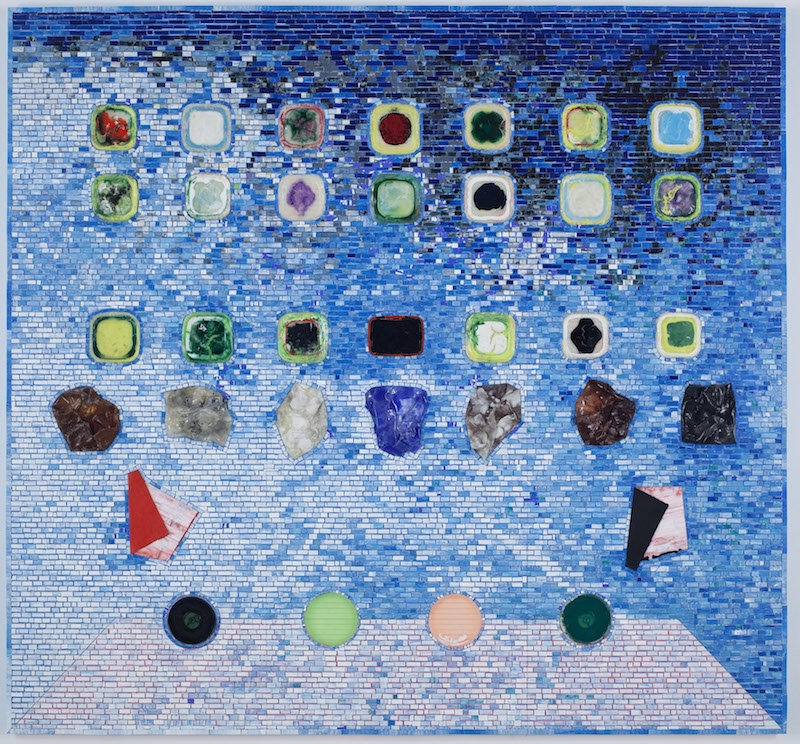This first retrospective of Jack Whitten’s work at a European institution is a bittersweet affair. It was conceived in collaboration with the Alabama-born artist, who appears in a studio-shot video at the outset of the show; but Whitten, who left us in January 2018 at the age of seventy-eight, did not live to attend its opening. That said, the show is a celebration rather than an elegy, and of more than one person. Whitten, whose early career was marked both by the civil rights struggles and his move to New York in 1960 to attend Cooper Union and master and rewrite the languages of Abstract Expressionism, had a uniquely selfless approach to painting. From the outset of this substantial exhibit, it’s made clear that his creativity related to feelings of gratitude for the diversity of artists and cultural and political figures whom he admired, and he adopted feeling-tones and aesthetics and merged them with his own. As a result, the paintings in Jack’s Jacks are both stylistically diverse and synthetic in manners that don’t, finally, recall anyone else’s work, while giving shout-outs at every turn.
The earliest work here, though, is focused on American discrimination, understandably given the temper of the era when it was made: Head IV Lynching (1964), painted while Whitten was in his mid-twenties, is a complicated, grey, approximately head-shaped smudge on black, with what could be a rope trailing from its upper edge; it’s abstraction as nightmare. Four years later, King’s Wish (Martin Luther’s Dream) (1968), painted in the year King was assassinated, is a vivacious, empurpled mix of sketchy figuration and swooping abstraction that seems to compound King’s optimism with febrile violence. Pointedly placed near it in the show’s opening phase, the atypical (for this exhibition) Red, Black, Green (1979–80) is a geometric abstraction – red and green squares within a larger, layered but approximately black one in rhythmically scraped paint, concentric white circles on it suggesting a rifle sight – that takes the colours of the pan-African flag and mingles them with threat in the language of Western modernism.
To an extent, though, these works are scene-setting for the thrust of the show, which moves in elevating fashion through a bespoke canon of inspirations from all quarters: it suggests, too, that greatness is a chain, a long one. Whitten makes a faintly Richteresque, smeary, evening-sky abstraction out of the luscious Delacroix’s Palette (1974). He delivers a scintillating, percussive trio of pulsing grids of multicoloured squares on canvas in Norman Lewis Triptych I (1985), paying homage to the African-American painter and scholar six years after his death, and also announcing the tessellated design that would become a hallmark of his nevertheless varied aesthetic roaming in the decades to come. In Bill’s Way, For Bill de Kooning (1990), the delicate pastel pinks and blues of de Kooning’s late canvases refract through gridded squares from what look like loose, flowing watercolour paintings, in a way that echoes the older painter’s liquefied composing but is not beholden to it: Whitten tangents off somewhere new, differently energised. If the painting probably couldn’t exist without de Kooning, it’s not in his shadow either.
It goes on like that, through respects paid not only to other artists (Arshile Gorky, Andy Warhol, Cy Twombly) but also musicians (Prince, John Coltrane), sportsmen (Joe DiMaggio, Muhammad Ali) and in the ersatz giant iPad screen Apps for Obama (2011) – a big, swimming-pool blue mosaic dotted with soft-edged squares – to the US’s first black president. The latter painting doesn’t feel illustrational in any way; all the choices seem subjective, personal, even oblique. Seeing all these names risks, superficially, a rebound effect, but in the end it’s a double bluff. Humility is strength, Jack’s Jacks asserts; it takes a strong person to admit that they need others. Here, from beyond the veil, Whitten admits it one more time.
Jack Whitten: Jack’s Jacks, Hamburger Bahnhof, Berlin, 29 March – 1 September 2019
From the Summer 2019 issue of ArtReview
